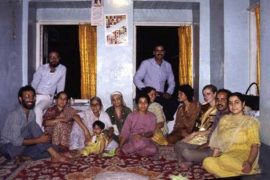Indrani Rahman captured everyone’s attention when she appeared in 1952’s Miss Universe swimsuit round, pairing her elegant little swimsuit with a round bindi and a meticulous hair bun adorned with gajra.
She was India’s first Miss India, an icon of beauty from a newly independent country that looked down on beauty pageants. However, Indrani Rahman gracefully maintained her confident image as not only a beauty queen but also one of the most prominent dancers in India.
Indrani Rahman was born to a well-known Indian classical dancer, Esther Luella Sherman and Ramalal Bajpai, an Indian engineer. Better known as Ragini Devi, the story of Rahman’s mother is one to beat the odds as well. Born in Michigan and brought up in Minnesota, Sherman found a passion for Indian culture and its dance during her years at the University of Minnesota. She married Bajpai in the 1920s, who was then pursuing his education in the U.S. and settled in India.
Ragini embraced Hinduism and ardently believed she was an Indian in her past life, destined to take up Indian classical dance. She changed her name to Ragini Devi, and her career as a dancer bloomed, making her one of the most well-known dancers in India.
Ragini had a pivotal role in the resurgence of traditional Indian dance. She studied Bharatanatyam in Madras under the famed Mylapore Gouri and was the first American woman to pursue Kathakali. She made Bharatanatyam and Kathakali famous all over the globe. In the 1930s, Ragini took advantage of the West’s curiosity about the East to popularise her dance in the US and Europe.
During a trip to the U.S., Ragini chanced upon a Roma psychic who had foreseen something much more significant: her daughter’s career would transcend her own, and it did. Indrani Rahman was rebellious, intelligent, and gorgeous. She stepped into her mother’s shoes but remained fearless to defy her. Just like Ragini, Indrani found fame on the grand stage of Indian classical dance.
“Nani took great pride … but she remained her severest critic … It was critical to keep up one’s training under leading gurus throughout a dancer’s career …,” Sukanya Rahman, Indrani’s daughter, writes in Dancing in the Family: An Unconventional Memoir of Three Women.
Indrani Rahman was born in a Chennai (then Madras) nursing home on September 19, 1930. Having a child did not stop Ragini Devi from touring and performing. Instead, she took a young Indrani with her. A four-year-old Indrani had to be coaxed by Nobel Laureate Rabindranath Tagore once as her mother gave a Kathakali performance at Santiniketan. Therefore, it should not be surprising that the young daughter of a legendary dancer would be impassioned by the graceful art that unfolded in front of her eyes all her life.
At only nine years old, Indrani began to train to specialise in Bharatanatyam, Odissi, Kuchipudi, and Mohini Attam. Like her mother, she was raised to be determined, pursue her dreams, and lead an independent life. So, when Indrani married Habib Rahman, a prominent architect, at the age of 15, she caused quite a stir by going against her mother’s wishes.
Habib Rahman was twenty-nine when the two met for the first time. He was an MIT graduate who took part in a dance theatre performance choreographed by Ragini. Indrani played a small role in the act. Handsome and charming, Rahman received blazing reviews from the show, and, in no time, the choreographer’s daughter and the star fell in love.
Indrani’s parents were against the union; however, in 1946, Indrani was pregnant, and the two went ahead and got married. At sixteen, Indrani was a mother and a wife, but like Ragini, it did not slow her down. By the 1950s, she had become the first professional dancer to introduce Odissi and Kuchipudi outside their traditional settings. Like Ragini Devi, Rahman is remembered for the revival of classical dance in India and for taking it across the globe.
The Miss India contest was a benchmark in her already successful career. As she developed her career as a classical dancer, she hesitated to enter the Miss Calcutta pageant and then the Miss India pageant, which led to Miss Universe in New York and California.
Ragini encouraged Indrani to participate; however, Indian society did not see beauty pageants as a reputable podium. Additionally, Indrani was a married woman and a mother. Throughout India, demonstrators came out on the streets during the Miss India event, denouncing the contest. However, when Indrani took the title of the first beauty queen, she balanced the crown with utmost grace. She became a sweetheart of the country.
“Newspapers were clamouring for interviews. Film offers were pouring in from Bombay, and as the telegrams and letters arrived, Mummy consigned them to the dustbin,” Sukanya noted in her book. “My mother, while she was thrilled at winning the contest and all the fabulous prizes, was eager to distance herself from the Hindi film world. She feared the whole beauty queen business would tarnish her rising reputation as a serious classical dancer.”
Indrani abhorred the idea that show business could eclipse her talent. Her respect for dance was limitless, and she wanted to maintain a pristine image to match that respect for her art.
She wrote to dance historian Mohan Khokar in a letter dated January 15, 1953. Art historian Sunil Kothari unearthed a copy in her scrapbook, revealing allusions to her modelling for Lipton tea.
“Please never mention to me or any one about that atrocious film of Liptons. I did it long ago to raise money for dance studies and have bitterly regretted it ever since. There is nothing I can do to stop its circulation. At least my name is not on it,” read the letter.
Rehman travelled extensively, performing all across India and beyond borders. While Ragini popularised Indian classical dance in Europe and the U.S., Indrani took it even beyond. She danced as a soloist and with her dance ensemble across Europe, the USSR, Southeast Asia, America, Canada, the Caribbean, Africa, and Australia.
During Nehru’s visit to Washington, DC, in 1961, Indrani performed as India’s cultural ambassador for the U.S. President John F. Kennedy. She has also entertained Emperor Haile Selassie, Queen Elizabeth II, Mao Zedong, Nikita Khrushchev, and Fidel Castro.
In 1976, Indrani joined the faculty of the Juilliard School’s dance department at New York’s Lincoln Center for the Performing Arts. She also lectured at various American colleges, including Harvard, and spent her final years touring and performing widely in the United States until her death in 1999.
Indrani Rahman, India’s first beauty icon, took classical dancing far beyond its bounds. Her dedication and reverence for her artistic medium distinguished her as an artist unfazed by fame.
-30-
Copyright©Madras Courier, All Rights Reserved. You may share using our article tools. Please don't cut articles from madrascourier.com and redistribute by email, post to the web, mobile phone or social media.Please send in your feed back and comments to [email protected]











